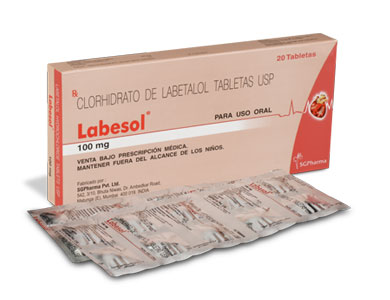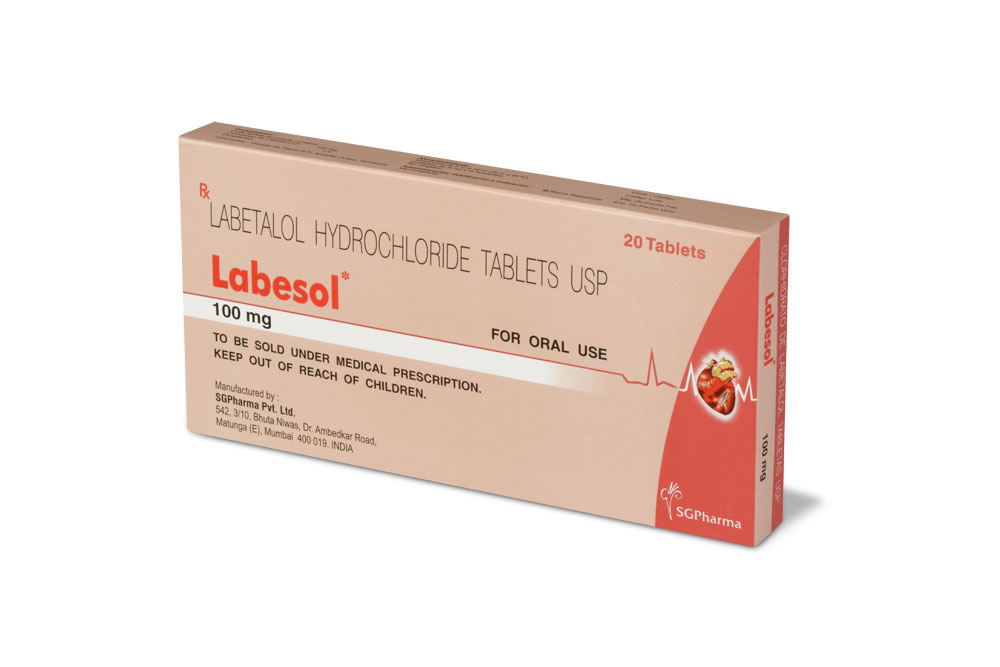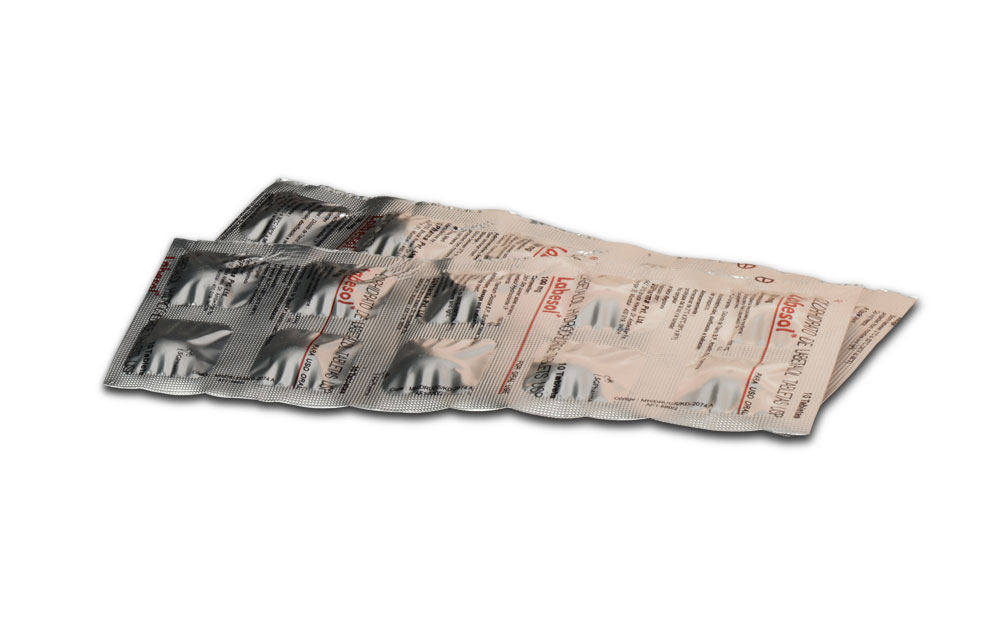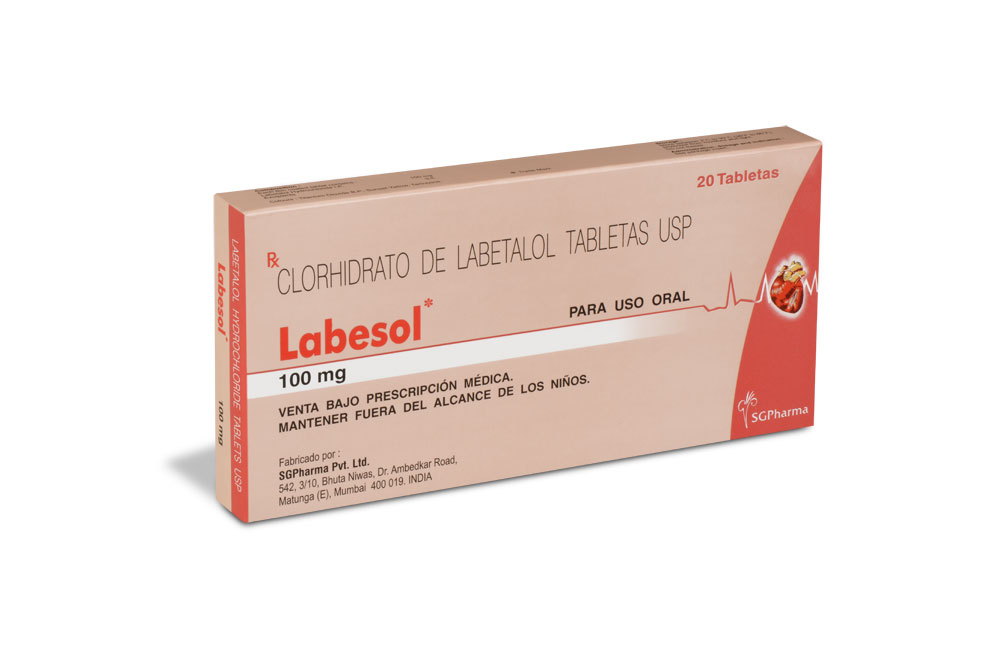
100 mg
For the use of a Registered Medical Practitioner or a Hospital or a Institution only.
LABESOL (Labetalol Hydrochloride) is an adrenergic receptor blocking agent that has both selective alpha1-adrenergic and nonselective beta-adrenergic receptor blocking actions in a single substance. Labetalol (HCl) is a racemate. Chemically, Labetalol Hydrochloride is designated as 5-[1-hydroxy-2-(1-methyl-3-phenylpropyl)amino]ethyl]-salicylamide monohydrochloride. Its molecular formula is C19H24N2O3•HCl and its molecular weight is 364.87.
STRUCTURAL FORMULA :
Its structural formula is :
-Structure.jpg)
LABESOL is an orange coloured, circular biconvex film coated tablet.
COMPOSITION :
Each film coated tablet contains :
Labetalol Hydrochloride I.P. 100 mg
Excipients q.s.
Colours : Titanium Dioxide B.P., Sunset Yellow, Tartrazine.
ACTIONS :
Labetalol combines both selective, competitive, alpha1-adrenergic blocking and nonselective, competitive, beta-adrenergic blocking activity in a single substance. Labetalol lowers blood pressure by blocking peripheral arteriolar a-adrenoceptors, thus reducing peripheral resistance and by concurrent b-blockade, protects the heart from reflex sympathetic drive that would otherwise occur. Cardiac output is not significantly reduced at rest or after moderate exercise. Increases in systolic blood pressure during exercise are reduced but corresponding changes in diastolic pressure are essentially normal. All these effects would be expected to benefit hypertensive patients. Labetalol does not adversely affect renal function and is particularly suitable for use in hypertensive patients with renal disease.
The capacity of labetalol to block alpha receptors in man has been demonstrated by attenuation of the pressor effect of phenylephrine and by a significant reduction of the pressor response caused by immersing the hand in ice-cold water (“cold pressor test”). Labetalol’s beta1-receptor blockade in man was demonstrated by a small decrease in the resting heart rate, attenuation of tachycardia produced by isoproterenol or exercise, and by attenuation of the reflex tachycardia to the hypotension produced by amyl nitrite. Beta2-receptor blockade was demonstrated by inhibition of the isoproterenol-induced fall in diastolic blood pressure. Both the alpha- and beta-blocking actions of orally administered labetalol HCl contribute to a decrease in blood pressure in hypertensive patients. Labetalol consistently, in dose-related fashion, blunted increases in exercise-induced blood pressure and heart rate, and in their double product. The pulmonary circulation during exercise was not affected by labetalol hydrochloride dosing. Single oral doses of labetalol HCl administered in patients with coronary artery disease had no significant effect on sinus rate, intraventricular conduction, or QRS duration. The AV conduction time was modestly prolonged in 2 of 7 patients. In another study, intravenous labetalol slightly prolonged AV nodal conduction time and atrial effective refractory period with only small changes in heart rate. The effects on AV nodal refractoriness were inconsistent. Labetalol produces dose-related falls in blood pressure without reflex tachycardia and without significant reduction in heart rate, presumably through a mixture of its alpha-blocking and beta-blocking effects. Haemodynamic effects are variable with small nonsignificant changes in cardiac output seen in some studies but not others, and small decreases in total peripheral resistance. Elevated plasma renins are reduced. Doses of Labetalol HCl that controlled hypertension did not affect renal function in mild to severe hypertensive patients with normal renal function.
Due to the alpha1-receptor blocking activity of labetalol, blood pressure is lowered more in the standing than in the supine position, and symptoms of postural hypotension (2 %), including rare instances of syncope, can occur. Following oral administration, when postural hypotension has occurred, it has been transient and is uncommon when the recommended starting dose and titration increments are closely followed. Symptomatic postural hypotension is most likely to occur 2 to 4 hours after a dose, especially following the use of large initial doses or upon large changes in dose. The peak effects of single oral doses of labetalol HCl occur within 2 to 4 hours. The duration of effect depends upon dose, lasting at least 8 hours following single oral doses of 100 mg and more than 12 hours following single oral doses of 300 mg. The maximum, steady-state blood pressure response upon oral, twice-a-day dosing occurs within 24 to 72 hours.
PHARMACOKINETICS :
Labetalol is completely absorbed from the gastrointestinal tract with peak plasma levels occurring 1 to 2 hours after oral administration. The relative bioavailability of labetalol HCl tablets compared to an oral solution is 100 %. The absolute bioavailability (fraction of drug reaching systemic circulation) of labetalol when compared to an intravenous infusion is 25 %; this is due to extensive “first-pass” metabolism. Despite “first-pass” metabolism there is a linear relationship between oral doses of 100 to 3000 mg and peak plasma levels. The absolute bioavailability of labetalol is increased when administered with food. The plasma half-life of labetalol following oral administration is about 6 to 8 hours. Steady-state plasma levels of labetalol during repetitive dosing are reached by about the third day of dosing. In patients with decreased hepatic or renal function, the elimination half-life of labetalol is not altered; however, the relative bioavailability in hepatically impaired patients is increased due to decreased “firstpass” metabolism. The metabolism of labetalol is mainly through conjugation to glucuronide metabolites. These metabolites are present in plasma and are excreted in the urine and, via the bile, into the faeces. Approximately 55 % to 60 % of a dose appears in the urine as conjugates or unchanged labetalol within the first 24 hours of dosing. Labetalol has been shown to cross the placental barrier in humans. Only negligible amounts of the drug crossed the blood-brain barrier in animal studies. Labetalol is approximately 50 % protein bound. Neither haemodialysis nor peritoneal dialysis removes a significant amount of labetalol from the general circulation (< 1 %).
Administration :
LABESOL is administered by oral route.
Dosage :
DOSAGE MUST BE INDIVIDUALIZED. The recommended initial dose is 100 mg twice daily whether used alone or added to a diuretic regimen. After 2 or 3 days, using standing blood pressure as an indicator, dosage may be titrated in increments of 100 mg b.i.d. every 2 or 3 days. The usual maintenance dosage of labetalol hydrochloride is between 200 and 400 mg twice daily. Since the full antihypertensive effect of labetalol is usually seen within the first 1 to 3 hours of the initial dose or dose increment, the assurance of a lack of an exaggerated hypotensive response can be clinically established in the office setting. The antihypertensive effects of continued dosing can be measured at subsequent visits, approximately 12 hours after a dose, to determine whether further titration is necessary. Patients with severe hypertension may require from 1200 mg to 2400 mg per day, with or without thiazide diuretics. Should side effects (principally nausea or dizziness) occur with these doses administered b.i.d., the same total daily dose administered t.i.d. may improve tolerability and facilitate further titration. Titration increments should not exceed 200 mg b.i.d. When a diuretic is added, an additive antihypertensive effect can be expected. In some cases this may necessitate a labetalol hydrochloride dosage adjustment. As with most antihypertensive drugs, optimal dosages of LABESOL are usually lower in patients also receiving a diuretic. When transferring a patient from other antihypertensive drugs, LABESOL should be introduced as recommended and the dosage of the existing therapy progressively decreased.
Initiation of dosing with LABESOL: Subsequent oral dosing with LABESOL should begin when it has been established that the supine diastolic blood pressure has begin to rise. The recommended initial dose is 200 mg, followed in 6-12 hours by an additional dose of 200 or 400 mg, depending on the Blood pressure response. Thereafter, inpatient Titration with LABESOL may proceed as follows :
Inpatients Titration instruction.
| Regimen | Daily Dose |
| 200 mg b.i.d. | 400 mg |
| 400 mg b.i.d. | 800 mg |
| 800 mg b.i.d. | 1600 mg |
| 1200 mg b.i.d. | 2400 mg |
* If needed, the total daily dose may be given in 3 divided dose.
While in hospital, the dose of LABESOL may be increased at one day intervals to achieve the desired blood pressure reduction. Elderly Patients : As in the general patients population, LABESOL therapy may be initiated at 100 mg twice daily and titrated upwards in increments of 100 mg b.i.d. as required for control of blood pressure. Since some elderly patients eliminate LABESOL more slowly, however, adequate control of blood pressure may be achieved at a lower maintenance dosage compared to the general population. The majority of elderly patients will require between 100 and 200 mg b.i.d.
CONTRAINDICATIONS :
LABESOL is contraindicated in 2nd or 3rd degree heart block, cardiogenic shock and other conditions associated with severe and prolonged hypotension or severe bradycardia. When peripheral vasoconstriction suggests low cardiac output, the use of LABESOL to control hypertensive episodes following acute myocardial infarction is contraindicated. Beta-blockers, even those with apparent ardioselectivity, should not be used in patients with asthma or a history of obstructive airways disease. Labetalol is contraindicated for patients known to have hypersensitivity to the medicine. LABESOL contains lactose which is contra-indicated in patients with galactosaemia, the glucose-galactose malabsorption syndrome, or lactase deficiency.
Hepatic Injury :
Severe hepatocellular injury, confirmed by rechallenge in at least one case, occurs rarely with therapy with labetalol. The hepatic injury is usually reversible, but hepatic necrosis and death have been reported. Injury has occurred after both short-and long-term treatment and may be slowly progressive despite minimal symptomatology. Similar hepatic events have been reported with a related compound, dilevalol hydrochloride, including two deaths. Dilevalol hydrochloride is one of the four isomers of labetalol hydrochloride. Thus, for patients taking labetalol, periodic determination of suitable hepatic laboratory tests would be appropriate. Laboratory testing should also be done at the very first symptom or sign of liver dysfunction (e.g., pruritus, dark urine, persistent anorexia, jaundice, right upper quadrant tenderness, or unexplained “flu-like” symptoms). If the patient has jaundice or laboratory evidence of liver injury, labetalol should be stopped and not restarted.
Cardiac Failure :
Sympathetic stimulation is a vital component supporting circulatory function in congestive heart failure. Beta blockade carries a potential hazard of further depressing myocardial contractility and precipitating more severe failure. Although beta-blockers should be avoided in overt congestive heart failure, if necessary, labetalol can be used with caution in patients with a history of heart failure who are well-compensated. Congestive heart failure has been observed in patients receiving labetalol hydrochloride. Labetalol does not abolish the inotropic action of digitalis on heart muscle.
In Patients Without a History of Cardiac Failure :
In patients with latent cardiac insufficiency, continued depression of the myocardium with beta-blocking agents over a period of time can, in some cases, lead to cardiac failure. At the first sign or symptom of impending cardiac failure, patients should be fully digitalized and/or be given a diuretic, and the response observed closely. If cardiac failure continues, despite adequate digitalization and diuretic, therapy with labetalol should be withdrawn (gradually if possible).
Exacerbation of Ischaemic Heart Disease Following Abrupt Withdrawal :
Angina pectoris has not been reported upon labetalol discontinuation. However, hypersensitivity to catecholamines has been observed in patients withdrawn from beta-blocker therapy; exacerbation of angina and, in some cases, myocardial infarction have occurred after abrupt discontinuation of such therapy. When discontinuing chronically administered labetalol, particularly in patients with ischaemic heart disease, the dosage should be gradually reduced over a period of 1 to 2 weeks and the patient should be carefully monitored. If angina markedly worsens or acute coronary insufficiency develops, labetalol administration should be reinstituted promptly, at least temporarily, and other measures appropriate for the management of unstable angina should be taken. Patients should be warned against interruption or discontinuation of therapy without the physician’s advice. Because coronary artery disease is common and may be unrecognized, it may be prudent not to discontinue therapy with labetalol abruptly even in patients treated only for hypertension.
Pheochromocytoma :
Labetalol has been shown to be effective in lowering the blood pressure and relieving symptoms in patients with pheochromocytoma. However, paradoxical hypertensive responses have been reported in a few patients with this tumor; therefore, use caution when administering labetalol to patients with pheochromocytoma.
Diabetes Mellitus and Hypoglycaemia :
Beta-adrenergic blockade may prevent the appearance of premonitory signs and symptoms (e.g., tachycardia) of acute hypoglycaemia. This is especially important with labile diabetics. Beta-blockade also reduces the release of insulin in response to hyperglycaemia; it may therefore be necessary to adjust the dose of antidiabetic drugs.
Major Surgery :
The necessity or desirability of withdrawing beta-blocking therapy prior to major surgery is controversial. Protracted severe hypotension and difficulty in restarting or maintaining a heartbeat have been reported with beta-blockers. The effect of labetalol’s alpha-adrenergic activity has not been evaluated in this setting. A synergism between labetalol and halothane anaesthesia has been shown.
PRECAUTIONS :
General
Impaired Hepatic Function :
Labetalol should be used with caution in patients with impaired hepatic function since metabolism of the drug may be diminished
Jaundice or Hepatic Dysfunction :
(see WARNINGS).
Information for Patients :
As with all drugs with beta-blocking activity, certain advice to patients being treated with labetalol is warranted. This information is intended to aid in the safe and effective use of this medication. It is not a disclosure of all possible adverse or intended effects. While no incident of the abrupt withdrawal phenomenon (exacerbation of angina pectoris) has been reported with labetalol, dosing with LABESOL should not be interrupted or discontinued without a physician’s advice. Patients being treated with LABESOL should consult a physician at any signs or symptoms of impending cardiac failure or hepatic dysfunction. Also, transient scalp tingling may occur, usually when treatment with LABESOL is initiated.
Laboratory Tests :
As with any new drug given over prolonged periods, laboratory parameters should be observed over regular intervals. In patients with concomitant illnesses, such as impaired renal function, appropriate tests should be done to monitor these conditions.
LABESOL should be used cautiously in diabetic patients.
Pregnancy : Pregnancy Category C.
Teratogenic Effects :
Teratogenic studies have been performed with labetalol in rats and rabbits at oral doses up to approximately 6 and 4 times the maximum recommended human dose (MRHD), respectively. No reproducible evidence of foetal malformations was observed. Increased foetal resorptions were seen in both species at doses approximating the MRHD. A teratology study performed with labetalol in rabbits at intravenous doses up to 1.7 times the MRHD revealed no evidence of drug-related harm to the foetus. There are no adequate and well-controlled studies in pregnant women. Labetalol should be used during pregnancy only if the potential benefit justifies the potential risk to the foetus.
Nonteratogenic Effects :
Hypotension, bradycardia, hypoglycaemia, and respiratory depression have been reported in infants of mothers who were treated with labetalol for hypertension during pregnancy. Oral administration of labetalol to rats during late gestation through weaning at doses of 2 to 4 times the MRHD caused a decrease in neonatal survival.
Nursing mothers :
Small amounts of Labetalol (approximately 0.004 % of the maternal dose) are excreted in human milk. Caution should be exercised when Labetalol Hydrochloride is administered to a nursing woman.
Paediatric Use :
Safety and effectiveness in paediatric patients have not been established.
INTERACTIONS :
Since Labetalol Hydrochloride may be administered to patients already being treated with other medications, including other antihypertensive agents, careful monitoring of these patients is necessary to detect and treat promptly any undesired effect from concomitant administration. In one survey, 2.3 % of patients taking Labetalol orally in combination with tricyclic antidepressants experienced tremor as compared to 0.7 % reported to occur with Labetalol alone. The contribution of each of the treatments to this adverse reaction is unknown, but the possibility of a drug interaction cannot be excluded. Drug possessing beta-blocking properties can blunt the bronchodilator effect of beta receptor agonist drugs in patients with bronchospasm; therefore, doses greater than the normal antiasthmatic dose of beta-agonist bronchodilator drugs may be required. Cimetidine has been shown to increase the bioavailability of Labetalol administered orally. Since this could be explained either by enhanced absorption or by an alteration of hepatic metabolism of Labetalol, special care should be used in establishing the dose required for blood pressure control in such patients. Synergism has been shown between halothane anaesthesia and intravenously administered Labetalol. During controlled hypotensive anaesthesia using Labetalol in association with halothane, high concentrations (3 % or above) of halothane should not be used because the degree of hypotension will be increased and because of the possibility of a large reduction in cardiac output and an increase in central venous pressure. The anaesthesiologist should be informed when a patient is receiving Labetalol.
Labetalol blunts the reflex tachycardia produced by nitroglycerin without preventing its hypotensive effect. If Labetalol is used with nitroglycerin in patients with angina pectoris, additional antihypertensive effects may occur. Care should be taken if Labetalol is used concomitantly with calcium antagonists of the verapamil type.
Drug / laboratories test interactions :
The presence of Labetalol metabolites in the urine may result in falsely elevated levels of urinary catecholamines, metanephrine, normetanephrine and vanillylmandelic acid (VMA) when measured by fluorimetric or photometric methods. In screening patients suspected of having a pheochromocytoma and being treated with Labetalol, a specific method, such as a high performance liquid chromatographic assay with solid phase extraction (e.g. J Chromatogr 385:241,1987) should be employed in determining levels of atecholamines. Labetalol has also been reported to produce a false-positive test for amphetamine when screening urine for the presence of drugs using the commercially available assay methods Toxi-Lab A® (thin-layer chromatographic assay) and Emit-d.a.u.® (radioenzymatic assay). When patients being treated with Labetalol have a positive urine test for amphetamine using these techniques, confirmation should be made by using more specific methods, such as a gas chromatographic-mass spectrometer technique.
SIDE EFFECTS :
LABESOL is usually well tolerated. Most adverse effects have been mild and transient and, in controlled trials involving 92 patients, did not require Labetalol withdrawal. Symptomatic postural hypotension (incidence, 58 %) is likely to occur if patients are tilted or allowed to assume the upright position within 3 hours of receiving Labetalol HCl. Moderate hypotension occurred in 1 of 100 patients while supine. Increased sweating was noted in 4 of 100 patients and flushing occurred in 1 of 100 patients.
The following convention has been utilised for the classification of frequency :
Very common ≥1/10, common ≥ 1/100, < 1/10, uncommon ≥1/1000 and < 1/10000 and < 1/1000, very rare < 1/10000. Side-effects indicated by a hash (#) are usually transient and occur during the first few weeks of treatment.
Immune system disorders :
Common : Hypersensitivity.
Hypersensitivity reactions reported include rash, pruritus, dyspnoea and very rarely, drug fever or angioedema.
Cardiac disorders :
Rare : Bradycardia.
Very rare : Heart Block.
Vascular disorders :
Common : # Postural hypotension.
Very rare : Exacerbation of the symptoms of Raynaud’s Syndrome.
Pronounced postural hypotension may occur if patients are allowed to assume the upright position within 3 hours of receiving LABESOL.
Respiratory, thoracic and mediastinal disorders :
Common : # Nasal congestion.
Hepatobilary disorders :
Common : Raised liver function tests.
Very rare : Hepatitis, hepatocellular jaundice, cholestatic
jaundice, Hepatic necrosis.
The signs and symptoms of hepatobilary disorders are usually reversible on withdrawal of the drug.
Overdosage with Labetalol HCl causes excessive hypotension that is posture sensitive and sometimes, excessive bradycardia. Patients should be placed supine and their legs raised if necessary to improve the blood supply to the brain. If overdosage with Labetalol HCl follows oral ingestion, gastric lavage or pharmacologically induced emesis (using syrup of Ipecac) may be useful for removal of the drug shortly after ingestion. The following additional measures should be employed if necessary :

 Cardiovascular
Cardiovascular








